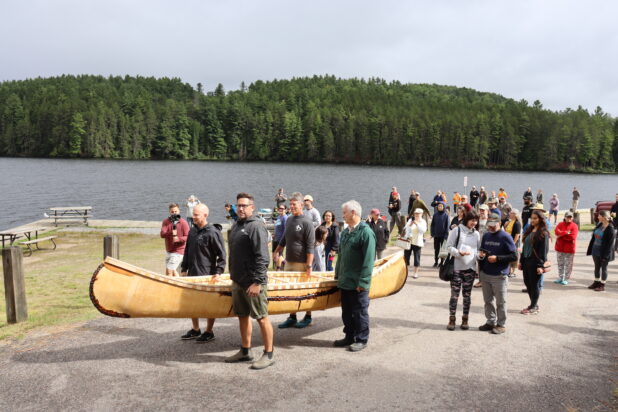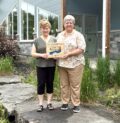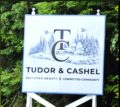Headline News
Second week of Algonquin Park birch bark canoe build went smoothly
August 30, 2022

By Mike Riley
Local Journalism Initiative Reporter
Last week, Bancroft This Week brought you the story of a two-week long birch bark canoe build being undertaken up in Algonquin Park by master canoe builder Chuck Commanda. This is the first canoe to be built in the upper stretches of Madaoueskarini (Madawaska River) Algonquin territory in decades and is the repatriation of ancestral practices back to unceded Algonquin territory. This week, we update the story, including how the second week of the build went and its completion, culminating in the canoe’s launch into Lake Opeongo for its first official paddle.
From Kitigan Zibi (a First Nations territory of the Kitigan Zibi Anishinabeg, an Algonquin band, that borders southwest on the town of Maniwaki, Quebec), Commanda started this 14-foot birch bark canoe build back on Aug. 15 at the Algonquin Outfitters Lake of Two Rivers Store in Algonquin Park. He did the build with his partner Jo-Anne Dumoulin and many other helpers over the course of the two weeks. Christine Luckasavitch, the lead cultural consultant with the project, says that she and Commanda had talked about him building a birch bark canoe in Algonquin Park for a decade and had wanted to do it in the summer of 2020 but it had been delayed by COVID-19 restrictions.
The white birch harvested for the build was done in partnership with the Algonquin Forestry Authority, Waaseyaa Consulting, Commanda, Simon Brascoupe (Algonquin artist), Algonquin Outfitters and its owner Rich Swift and the Swift family, in partnership with Ontario Parks, Camp Pathfinder (a boys’ summer camp in Algonquin Park) and The Friends of Algonquin Park.
Commanda has built canoes since childhood under the guidance of his grandparents, Mary and William Commanda. He has done so in the traditional Algonquin style for over a decade, while teaching canoe building, birch bark basket making and snowshoe making to Indigenous and non-Indigenous people of all ages. Over the years, his elder family members built over 100 birchbark canoes and four of these canoes are permanently displayed at Peterborough’s Canadian Canoe Museum.
Luckasavitch is the owner and executive consultant with Waaseyaa Consulting, one of the build’s sponsors, and she put out a press release back on Aug. 11, explaining that the intention of the build was connection and/or reconnection with ancestral skills, such as birch bark canoe building, and to make them accessible to Algonquin community members and their Indigenous neighbours. She invited everyone to come observe and take part in the build, no experience being required. She also said that the build was open to the general public so that visitors to Algonquin Park will understand that the land remains Anishinaabeg territory.
Chris Bosworth is the chief marketing officer with Algonquin Outfitters, and he was with Commanda a few weeks ago getting some of the materials for the build with Eli from the Algonquin Forestry Authority. He told The Bancroft Times on Aug. 24 that things have been going great over the past week.
“We made the move to the Lake Opeongo Store location and it was smooth. The weather has cooperated with only substantial rain on Monday, but the tent gives lots of coverage,” he says.
Bosworth says that there have been many other people who participated in the build, in addition to Camp Pathfinder, who helped out with it last week.
“There have been Ontario Parks staff, Algonquin Forestry Authority staff, members of many Indigenous communities, as well as many people who’d been following the build on social media or just happened to see it on their visit to the park. The build overall has been very smooth,” he says.
On Aug. 24, Commanda told Bancroft This Week that the canoe build went really well, and that there were a couple of issues, but nothing major. He confirms he will be ready to launch the canoe into Lake Opeongo Aug. 26.
“Yes, we had lots of people who volunteered and had lots of fun while learning about Algonquin culture, the history of the canoe and the sacred teachings of North America’s First Nations. As I already mentioned, there were a few minor issues such as some lashings were loose, stems were incorrectly sewn, both of which had to be undone and redone,” he says.
Luckasavitch revealed that Camp Pathfinder chose a name for the newly built canoe; it’s called Madawaska. She says they chose that name because the Madawaska is a major river in unceded Algonquin territory and the headwaters of the Madawaska is where Camp Pathfinder is located, on Source Lake.
On Aug. 26, the day of the canoe’s launch, approximately 130 people showed up at the Algonquin Outfitters Opeongo Store. After performing a smudging ceremony to bless and cleanse the tools, materials, the set and then himself and his helpers, Commanda thanked everyone who had helped out with the build. This included all the sponsors, the people who helped build the canoe over the past two weeks and finally his ancestors, who he said had guided him in the build overall.
Luckasavitch said that the completed canoe will be placed somewhere within Algonquin Park.
“We’re still kind of working it out but I know it will be here [at the Opeongo Store] for a bit anyway,” she says.
Rachel McCrae helped out with some threading on the canoe and applying spruce gum sealant to it over the previous couple of days.
“It’s just like caulking but it’s hot. It’s like working with hot glue. So, the way you did it, you licked your finger and then you smeared some on, because otherwise it’s too hot. That’s why you’re licking to get the water on. Actually, we were joking, some of our DNA is in this canoe because of all the times we licked and applied the gum,” she says.
Susan Oling said her daughter had done some work on the canoe and that she had taken some pictures of it the previous day, as she’s a photographer. She said that Commanda’s Algonquin lineage is the same that her grandmother belonged to, so that’s why she wanted to participate as much as possible. Later on, she played a tribute song to the newly constructed canoe on her flute, written by David Maracle, a Mohawk from the Tyendinaga Nation.
Richard Swift, the owner of Algonquin Outfitters, thanked Commanda, saying he was honoured to have shared the project with him.
“We want to pay tribute to you and the amazing artwork you and your partner created. It’s been a lot of fun. We’ve enjoyed it. The thing that stands out for me is your spirit of teaching and your legacy of teaching the youth,” he says.
Commanda replied that he was happy to have teamed up with Algonquin Outfitters and make this happen.
“We’ve been working on this for 10 years and finally got to team up with a beautiful organization in the middle of our territory. But like every good thing, it always has to come to an end,” he says.
John Swick, Algonquin Park’s superintendent, spoke next, saying how great it was to see park users and especially the Indigenous community come out to watch and help out with the build.
“It was a way for them to come together, to tell stories. It was so great that Algonquin Park was able to host this for the past two weeks. A wise person once said to me, it’s not a park it’s a community,” he says.
Luckasavitch said that what she’d seen over the last two weeks was an incredible demonstration of community.
“It’s a step in a process of healing toward a united community, nation, as well as much larger too. For the community members here supporting this, it’s been a long time coming,” she says.
Luckasavitch then introduced two Algonquin matriarchs who she said paved the way for her to do the work that she does; Ethel LaValley and Jane Ann Chartrand.
Chartrand spoke first, saying that they had travelled and lived on the waters in the area for a long time.
“And to have Chuck come here and share his expertise, we are so fortunate. If you can visualize these canoes coming across the lake, hear the paddles making contact with the water, see the sun on the paddles and hear that canoe going through the water. Just visualize that because you’ll see it again,” she says.
LaValley said that it was an honour to look out at the crowd that had been learning, taking part and being part of the community over the past couple of weeks.
“We are all one community when you think about it. I want to thank the Creator for the past two weeks, for this blessed day and I want to say Chi- Miigwech [Thank you]. It’s my honour that you’re here in our territory and we welcome you any time,” she says.
The canoe was then carried from the tent out to the shores of Lake Opeongo, where it was placed into the water. Commanda and Dumoulin took the canoe out for its first official paddle, then let whomever else wanted to try it out do so. There was no shortage of attendees who didn’t want to take it out for a paddle. Commanda said he’d heard people describe paddling it like “floating on a leaf” since it felt so light compared to modern day canoes that are made of metal or fibreglass. Luckasavitch said it was “like butter to paddle” and even though it was really light, she felt it was very sturdy and solid.
The canoe was completed on Aug. 25, when Luckasavitch said they put on the prime pitch and took it out for a trial run to ensure it would float and had no other issues.
“Everybody took part. Really it was anyone that was here, even my little niece. She’s the shyest person and she was there taking part. Again, like I said before, it’s the outpouring of community support and people being involved. It’s really brought a lot of people together,” she says. “It’s one of those really, really beautiful projects.”




















